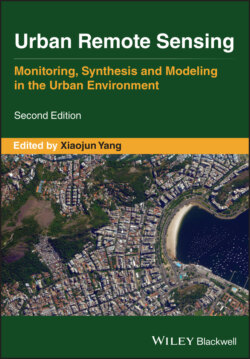Читать книгу Urban Remote Sensing - Группа авторов - Страница 33
2.3.2.1 Case Study: San Antonio, Texas
ОглавлениеTexas cities have undergone tremendous growth over the past several decades. Unlike other US cities that have witnessed population stagnation or decline (e.g. Detroit, Buffalo), cities such as San Antonio have undergone a 34% increase in population in less than two decades; from 1.1 million residents in 2000 to 1.5 million by 2018 (US Census 2019). Subsequently, such changes are reflected on the urban landscape through residential development (e.g. housing, apartment building) and growth of retail/commercial spaces. Multi‐temporal lidar data provide an ideal geospatial dataset with which to identify such changes in 3D space; in this brief case study, we use lidar‐derived 1 m spatial resolution raster data provided by the Army Geospatial Center collected during the summer months (leaf‐on conditions) in 2003 and 2012.
As an example of 3D change in an urban area, Figure 2.6 shows change in a commercial/retail space in southeast San Antonio between 2003 and 2012. When visually compared, the 2003 and 2012 DHMs (a and b respectively) indicate the removal of a large commercial building at the center and new build‐up in a portion of the space. When differenced via a dDHM, a single dataset can display the change including the type of change. For instance, Figure 2.6c shows the large building from 2003 in red that was demolished by 2012 where new build‐up is shown with blue. Interestingly, the dDHM reveals built‐up “ghosts” (red) that formerly dominated the urban landscape.
At the city‐scale (Figure 2.7), the dDHM highlights extreme (large area) changes well. In this case, many large buildings removed between 2003 and 2012 (red) are visible west/southwest of downtown and along the interstate southeast of downtown. New build‐up (blue) is especially prevalent along the highways in the east/northeast and north parts of the city. At this scale though, much of the change, which covers small areas, is indistinguishable. During this period, much of the northern area shown in Figure 2.7 was developed for residential land use, which can only partially be seen at this scale. In total, the dDHM‐based summation of volumetric change resulted in a net increase of around 27 Mm3 over this nine‐year period. Vegetation is included in this example and becomes apparent along the eastern extent of the analysis area stretching from north‐to‐south where tree canopy increased in size (some of this is a data artifact due to the 2012 data containing more vegetation points). In this way, dDHM calculation will reveal the changes in the urban environment but often not without also unveiling underlying data issues. In this example, because we did not have access to the raw lidar data, line‐up issues identified false changes on the landscape (e.g. building edges). Preprocessing can attempt to remove this noise but is sometimes unable to fully alleviate the problem.
